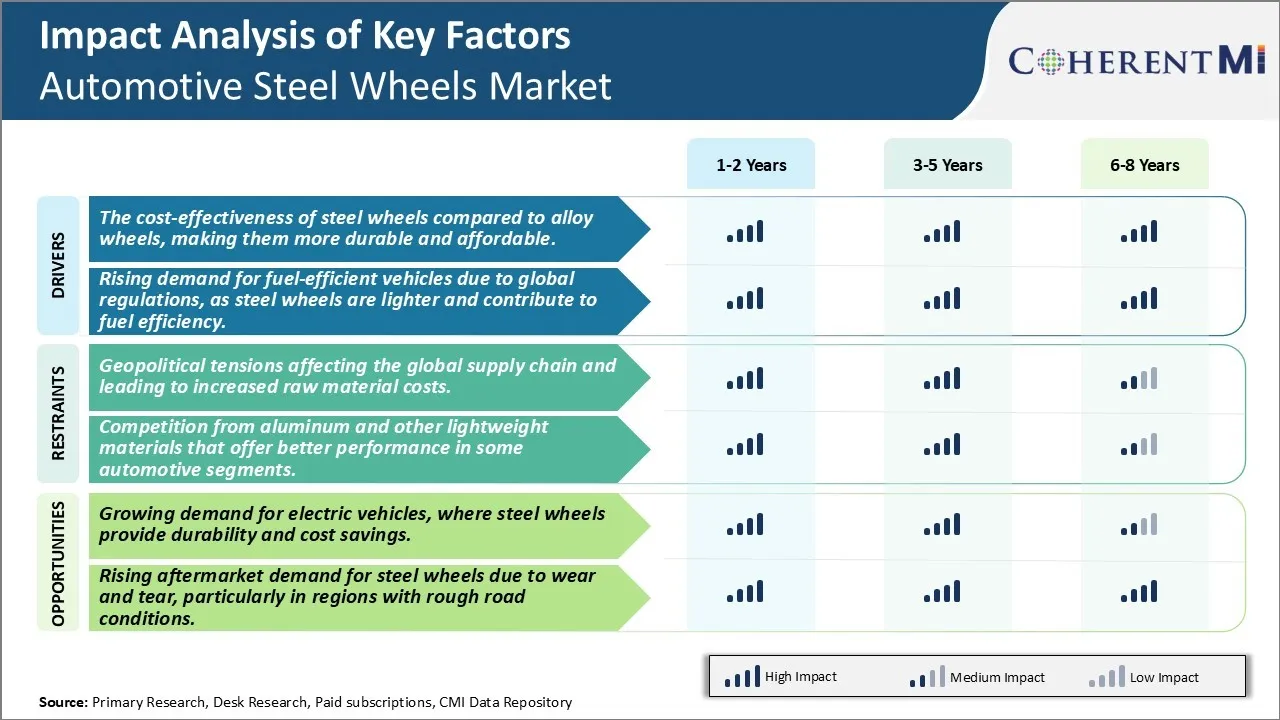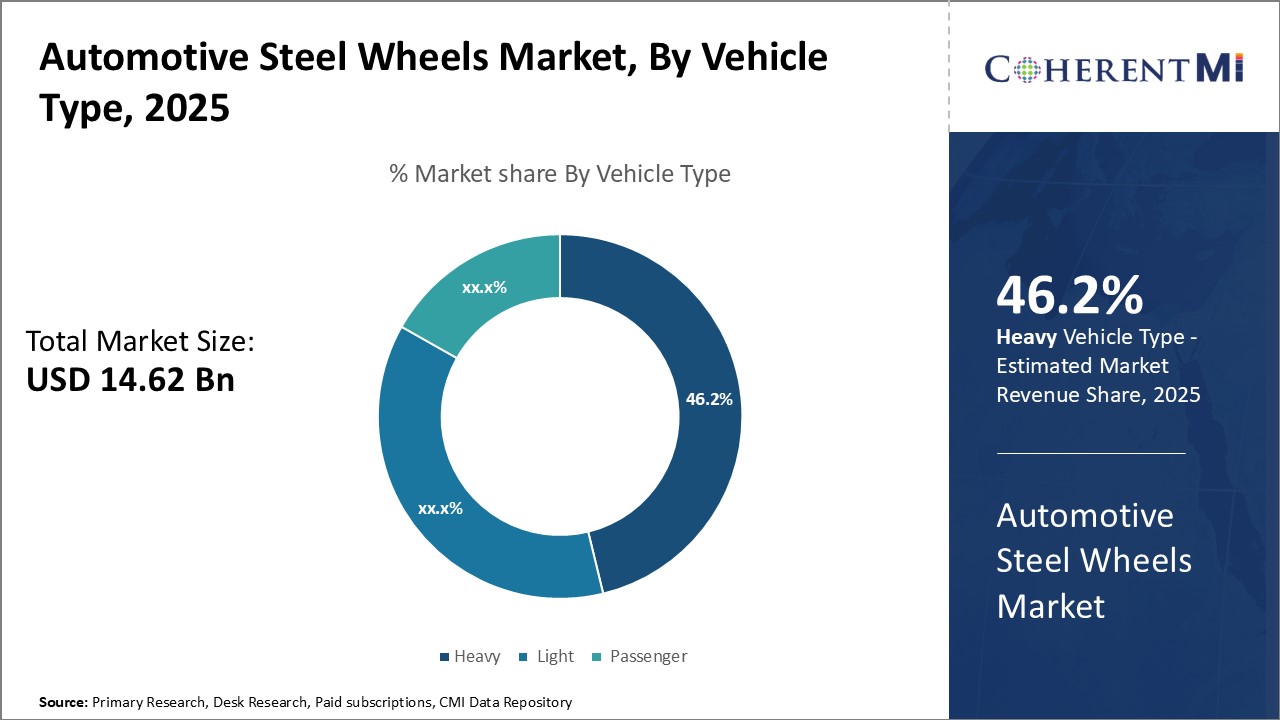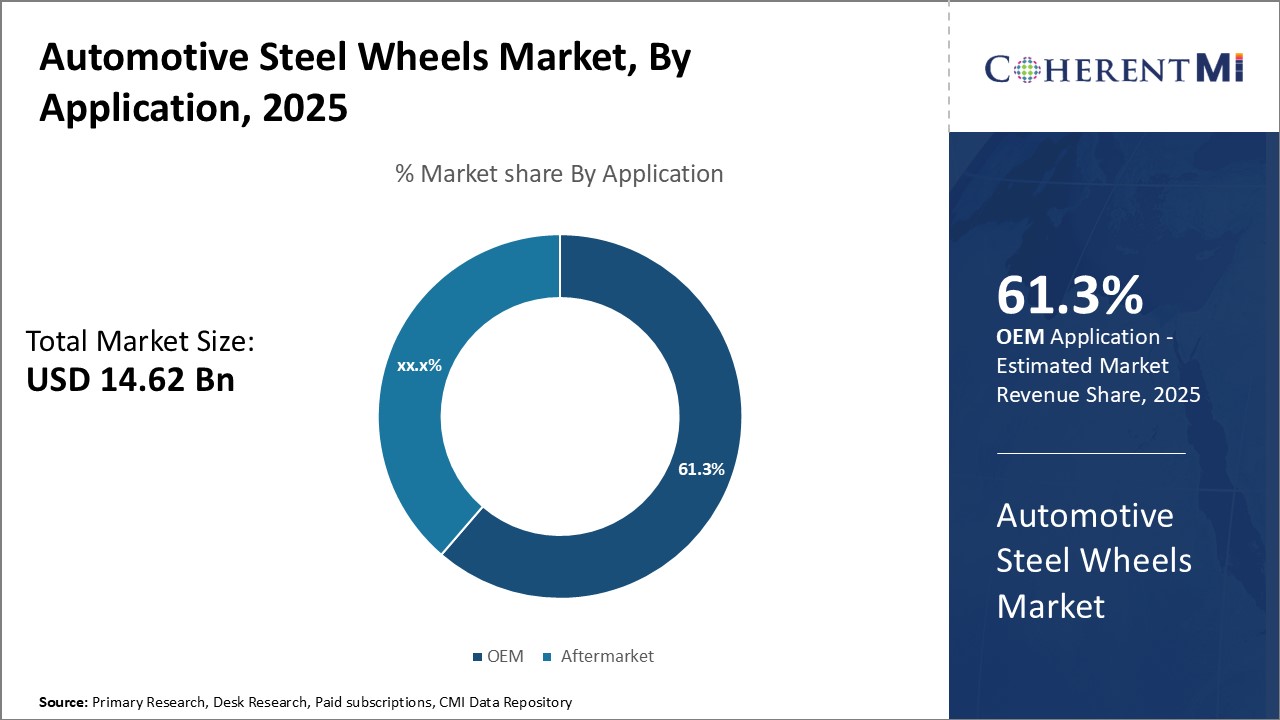Automotive Steel Wheels Market Size - Analysis
The automotive steel wheels market is expected to witness stable growth over the forecast period. Though facing competition from lightweight aluminum alloy wheels, steel wheels account for the majority of new vehicle production globally. Preference for steel wheels is higher in price-sensitive markets like India, Brazil, China and other developing economies where cost remains a key purchase consideration. OEM fitment of steel wheels particularly in entry and mid-level vehicle segments will drive steady demand through 2032.
Market Size in USD Bn
CAGR3.7%
| Study Period | 2025-2032 |
| Base Year of Estimation | 2024 |
| CAGR | 3.7% |
| Market Concentration | Medium |
| Major Players | Maxion Wheels, Thyssenkrupp AG, The Carlstar Group, LLC., Central Motor Wheel of America, Inc., Accuride Corporation and Among Others |
please let us know !
Automotive Steel Wheels Market Trends
Steel wheels represent a highly cost-effective solution for automakers compared to alloy wheels. Being significantly cheaper to produce than alloy wheels means that automakers are able to offer them as a standard fitment on many entry-level and economy models. This helps keep the initial purchase price of such vehicles low and makes them affordable for many price-sensitive consumers. Steel wheels are often nearly half or even a third of the price of a comparable set of alloy wheels. The lower costs are passed down to the end customer, making steel-wheeled variants of vehicles much more accessible financially.
Tightening emissions regulations around the world have put immense pressure on automakers to improve the efficiency and reduce the environmental impact of their vehicles. One way they are addressing this is by focusing more on weight savings throughout the vehicle, including the wheels. Steel wheels contribute to this goal as they are significantly lighter than alloy wheels of a similar design. Every extra ounce saved can help boost overall fuel economy marginally. For example, a set of steel wheels may weigh up to 10-20 lbs less than an aluminum alternative. Considering millions of vehicles are sold each year globally, the microscopic improvements add up substantially. Automakers are able to claim better fuel efficiency ratings and meet stringent new testing protocols partly because of the use of steel wheels. This has benefits for both manufacturers and consumers. The industry can avoid hefty fines for being non-compliant, while customers benefit from lower fuel bills. With fuel prices only moving higher, buyers are increasingly factoring running costs into their purchasing decisions. Steel wheels thus improve the value proposition of many mainstream models in light of rising demand for thriftier motoring.

Geopolitical tensions between major trading partners have escalated in recent years, disrupting global supply chains for automotive steel wheels. Raw materials like steel and aluminum are facing significant cost pressures as trade disagreements raise tariffs and create non-tariff barriers. Several steel producing nations have become less reliable suppliers due to the prevailing political atmosphere. With steel being a bulk commodity that is difficult to locally source in many markets, wheel manufacturers have limited options for alternatives and must absorb these additional costs. The profit margins for steel wheels, which are highly commoditized, provide little flexibility when input costs surge. Supply chain risks have increased as well from potential conflicts or sanctions that could cut off critical material streams. Unless geopolitical stability can be restored through cooperative trade policies, cost pressures on raw materials will persist and potentially force wheel producers to raise prices.
Market Opportunity- Growing Demand for Electric Vehicles Presents an Opportunity
Key winning strategies adopted by key players of Automotive Steel Wheels Market
Strategic Focus on Emerging Economies: Many automotive steel wheel manufacturers have strategically focused on emerging economies in Asia Pacific and Latin America to boost their sales volumes. For example, Iochpe-Maxion, one of the largest manufacturers, increased its presence in Brazil, China, and India between 2015 and 2020. This helped the company gain significant market share as vehicle production rapidly increased in these regions.
Mergers and Acquisitions: Consolidation through M&A's has been a top strategy. In the recent past, Titan International acquired Italy based Jwo Company, a leader in off-highway wheel manufacturing. This expanded Titan's expertise beyond agricultural wheels into construction and mining segments.
Segmental Analysis of Automotive Steel Wheels Market
 Insights, By Vehicle Type: Heavy Commercial Vehicle is Projected to Account for a Significant Market Share in the Forecast Period
Insights, By Vehicle Type: Heavy Commercial Vehicle is Projected to Account for a Significant Market Share in the Forecast PeriodBy Vehicle Type, heavy vehicles are projected to account for 46.2% in 2025 owing to increased infrastructure development. The heavy vehicle type segment within the automotive steel wheels market holds the largest share primarily owing to increased infrastructure development activities across the globe. Heavy vehicles such as trucks, buses and trailers see substantial demand from the construction as well as mining industries. Mega infrastructure projects pertaining to roads, tunnels, bridges and commercial buildings require robust material movement, thereby driving the need for heavy vehicles.

Insights, By Application, OEM is Expected to Account for a Leading Share in the Forecast Period
Additional Insights of Automotive Steel Wheels Market
Demand for automotive steel wheels is highly projected in the coming years mainly for their cost efficiency and durability. The steel wheels are known for their resilience and robustness that make them ideal for all extreme environments. Globally, the push towards lightweight materials is driving the trend. While the demand for steel wheel remains prevalent, the market is witnessing competition from aluminum products that are light in weight and improves the fuel consumption. Moreover, the growing focus on sustainability and recyclability contributes to green initiatives alongside stringent regulations on emissions.
Regional Insight:
Competitive overview of Automotive Steel Wheels Market
The major players operating in the Automotive Steel Wheels Market include Maxion Wheels, Thyssenkrupp AG, The Carlstar Group, LLC., Central Motor Wheel of America, Inc., Accuride Corporation, ALCAR Wheels GmbH, Automotive Wheels Ltd., Steel Strips Group, U.S. Wheel Corp., Topy America, Inc., Klassic Wheels Limited and CLN Coils Lamiere Nastri SpA.
Automotive Steel Wheels Market Leaders
- Maxion Wheels
- Thyssenkrupp AG
- The Carlstar Group, LLC.
- Central Motor Wheel of America, Inc.
- Accuride Corporation
Automotive Steel Wheels Market - Competitive Rivalry

Automotive Steel Wheels Market
(Dominated by major players)
(Highly competitive with lots of players.)
Recent Developments in Automotive Steel Wheels Market
- In June 2024, Hilton Metal Forging Ltd. entered the wagon axle manufacturing sector in India, reducing import dependency under the "Make in India" initiative, aimed at bolstering domestic production in critical industrial sectors.
- In September 2023, Maxion Wheels introduced its new product, Maxion BIONIC, a lightweight, eco-friendly steel wheel for light vehicles, designed by teams from Brazil, Mexico, the U.S., and Germany.
- In March 2024, Hyundai Motor India integrated AI, ML, and VR technology in its global passenger vehicle manufacturing center to transform its operations.
Automotive Steel Wheels Market Segmentation
- By Vehicle Type
- Heavy
- Light
- Passenger
- By Application
- OEM
- Aftermarket

Would you like to explore the option of buying individual sections of this report?
Yash Doshi is a Senior Management Consultant. He has 12+ years of experience in conducting research and handling consulting projects across verticals in APAC, EMEA, and the Americas.
He brings strong acumen in helping chemical companies navigate complex challenges and identify growth opportunities. He has deep expertise across the chemicals value chain, including commodity, specialty and fine chemicals, plastics and polymers, and petrochemicals. Yash is a sought-after speaker at industry conferences and contributes to various publications on topics related commodity, specialty and fine chemicals, plastics and polymers, and petrochemicals.
Frequently Asked Questions :
How Big is the Automotive Steel Wheels Market?
The Global Automotive Steel Wheels Market is estimated to be valued at USD 14.62 bn in 2025 and is expected to reach USD 18.85 Bn by 2032.
What will be the CAGR of the Automotive Steel Wheels Market?
The CAGR of the Automotive Steel Wheels Market is projected to be 3.5% from 2024 to 2031.
What are the key factors hampering the growth of the Automotive Steel Wheels Market?
The geopolitical tensions affecting the global supply chain and leading to increased raw material costs and competition from aluminum and other lightweight materials that offer better performance in some automotive segments are the major factor hampering the growth of the Automotive Steel Wheels Market.
What are the major factors driving the Automotive Steel Wheels Market growth?
The cost-effectiveness of steel wheels compared to alloy wheels, making them more durable and affordable and rising demand for fuel-efficient vehicles due to global regulations, as steel wheels are lighter and contribute to fuel efficiency. are the major factors driving the Automotive Steel Wheels Market.
Which is the leading Vehicle Type in the Automotive Steel Wheels Market?
Heavy vehicle type is the leading Vehicle Type segment.
Which are the major players operating in the Automotive Steel Wheels Market?
Maxion Wheels, Thyssenkrupp AG, The Carlstar Group, LLC., Central Motor Wheel of America, Inc., Accuride Corporation, ALCAR Wheels GmbH, Automotive Wheels Ltd., Steel Strips Group, U.S. Wheel Corp., Topy America, Inc., Klassic Wheels Limited, CLN Coils Lamiere Nastri SpA are the major players.